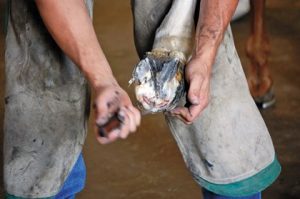Equine veterinarians commonly prescribe non-steroidal anti-inflammatory drugs (NSAIDS) for horses to treat a myriad of diseases, including colic, respiratory disease, and lameness. NSAIDs are also common in human medicine, and they include such drugs as aspirin and ibuprofen. Most horse owners have probably used NSAIDs too, such as phenylbutazone, or “bute” in one of their horses at some point in time.
“NSAIDs are an invaluable medication and have a multitude of uses in equine medicine. When used appropriately, they are very safe for horses”, said Bradley Nelson, DVM, a Washington State University equine medicine and surgery intern. “Like any medication, however, there can be side effects with NSAID use. It is important that horse owners only use these medications as directed by their veterinarian and when they are aware of the symptoms that horses with NSAID toxicity will demonstrate”.
The positive effects of NSAIDs include pain relief (analgesia) and the reduction of inflammation and fever. When a horse is injured, the body responds by producing inflammation. The horse will then likely have some associated swelling, pain, heat or redness in the affected area. This inflammatory process is a multiple-step pathway in the body and involves many enzymes. NSAIDs work by inhibiting an enzyme called cyclo-oxgenase (COX), which shuts down the pathway and reduces the inflammatory process. Depending upon the NSAID, other positive effects include blood thinning and the reduction of endotoxemia, or the presence of bacterial byproducts in the bloodstream.
The most commonly used NSAIDs are flunixin meglumine (Banamine) and phenylbutazone or “bute”. Other NSAIDs equine veterinarians use include firocoxib (Equioxx), ketoprofen (Ketofen), etodolac (Etogesic), aspirin, naproxen, and diclofenac (Surpass). Flunixin meglumine is typically given to horses with pain originating from internal organs, such as colic. Phenylbutazone is given for conditions that involve lameness or other problems involved with the horse’s bones, ligaments, and tendons.
“While some NSAIDs have similar potency and activity, they are not interchangeable,” Nelson said. “For example, although aspirin is the best medication for decreasing excessive blood clotting, it is not usually the best choice for musculoskeletal problems in horses.”
Some NSAIDs are reportedly safer to use than others, but no NSAID is free of risk. When used under recommended dosages, NSAIDs can be a valuable and economic choice for treating many equine diseases, but they can produce side effects when used inappropriately. Moreover, even at recommended doses, some horses can develop adverse effects.
The main side effects seen in horses occur in the gastrointestinal tract and kidneys. The pathways that regulate inflammation also help by producing substances called prostaglandins, which are needed to promote blood flow, increase mucus secretions, and decrease gastric acid secretions. Prolonged high doses of NSAIDs can decrease theses prostaglandins and make the horse susceptible to ulceration.
Clinical signs that can be seen with NSAID toxicity include diarrhea, colic, ulceration throughout the gastrointestinal tract (including the mouth), and weight loss. Kidney toxicity usually develops due to changes in the kidney’s blood flow. If these medications are given to dehydrated horses or those with preexisting kidney disease, they are more susceptible to toxicity. Clinical signs seen with kidney disease may include increased or decreased urination or straining to urinate. While some of these side effects are mild, severe disease can develop.
“If a horse is on an NSAID medication and develops some of these symptoms, stop giving the NSAID and consult a veterinarian,” Nelson said.
NSAIDs are formulated for horses in several ways, including oral, injectable, or topical. Phenylbutazone and flunixin meglumine come in oral and injectable formulations. A veterinarian will prescribe the most appropriate medication for an individual horse and help owners with the proper way to administer it.
“The injectable formulation should only be injected into the vein, and not in the muscle because tissue damage can result. In addition, the injectable form of flunixin meglumine has been associated with causing serious secondary bacterial infections,” Nelson said. The flunixin meglumine injectable formula is readily absorbed when given orally to the horse and is an excellent alternative to giving it in the muscle if an oral formulation is not available.
“The topical NSAID, Surpass is marketed to be applied on an affected area without exposing the entire body”, he said. “However, this NSAID is typically not as effective as phenylbutazone for moderate to severe lameness.”
He also recommended that typical safe doses for phenylbutazone (for an average 1,000 lb horse) should not exceed 3 grams daily for three days unless on the advice of a veterinarian. After three days, the dose should be decreased to prevent any adverse side effects. In many horses, these lower doses can be safely maintained for longer periods of time, possibly for several months. But some horses are more sensitive to NSAID toxicity and may develop problems with lower doses.
For an average size horse, flunixin meglumine use should not exceed 500mg (10mLs) every 12 hours. These doses are also reserved for more painful conditions and should not be given for more than two days prior to decreasing the dose.
“When these doses of phenylbutazone or flunixin meglumine are exceeded, usually the horse does not benefit from increased pain relief and is much more likely to be harmed by the side effects,” Nelson said. “If a horse is given too much of an NSAID, a veterinarian should be consulted as they can help prevent sever side effects before they occur.”
Generally, horses should not be given NSAIDs if they have preexisting kidney or gastrointestinal disease. But, depending upon the disease, a veterinarian can determine if NSAIDs can safely be used in these cases.
Reprinted from the WSU College of Veterinary Medicine
Equine News Winter 2010 issue.


